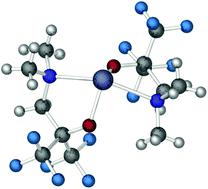当前位置:
X-MOL 学术
›
Dalton Trans.
›
论文详情
Our official English website, www.x-mol.net, welcomes your
feedback! (Note: you will need to create a separate account there.)
Evaluation of Sn(II) aminoalkoxide precursors for atomic layer deposition of SnO thin films
Dalton Transactions ( IF 3.5 ) Pub Date : 2021-09-08 , DOI: 10.1039/d1dt02480a James D Parish 1 , Michael W Snook 1 , Andrew L Johnson 1
Dalton Transactions ( IF 3.5 ) Pub Date : 2021-09-08 , DOI: 10.1039/d1dt02480a James D Parish 1 , Michael W Snook 1 , Andrew L Johnson 1
Affiliation

|
We have successfully prepared and structurally characterized a family of eight tin(II) heteroleptic complexes, [Sn(NR2)(ON)]x (NR2 = NMe2 (1a–d) or N(SiMe3)2 (2a–d); x = 1 or 2) and four homoleptic systems, [Sn(κ2-ON)2] (3a–d) from a series of aminoalcohols and fluorinated aminoalcohols (H{ON}) having a different number of methyl/trifluoromethyl substituents at the α-carbon atom, [HOC(R1)(R2)CH2NMe2] (R1 = R2 = H (H{dmae}) (a); R1 = H, R2 = Me (H{dmap}) (b); R1 = R2 = Me (H{dmamp}) (c); R1 = R2 = CF3 (H{Fdmamp}) (d)). The synthetic route used reactions of either [Sn{N(SiMe3)2}2] or [Sn(NMe2)2] with one or two equivalents of the aminoalcohols (a–d) in dry aprotic solvents leading to elimination of amines and formation of the Sn(II) species 1a–d, 2a–d and 3a–d respectively. All complexes were thoroughly characterized by NMR spectroscopy (1H, 13C, 19F, and 119Sn) as well as single-crystal X-ray diffraction studies. In all case the solid state molecular structures of the complexes have been unambiguously established: the solid state structures 1a–b and 1c are dimeric with central {Sn2N2} cores resulting from bridging {μ2-NMe2} units, in which the Sn(II) atoms are four-coordinate. In contrast, the solid state structures of complexes 1c and 2a–c possess similarly dimeric structures, with four-coordinate Sn(II) atoms, in which the oxygen atoms of the {ON} ligand bridge two Sn(II) centres to form dimers with a central {Sn2O2} core. Uniquely in this study, 2d, [Sn(κ2-O,N-OCMe2CH2NMe2){N(SiMe3)2}] is monomeric with a three coordinate Sn(II) centre. The homoleptic complexes 3a–d are all isostructural with monomeric four-coordinate structures with disphenoidal geometries. Solution state NMR studies reveal complicated ligand exchange processes in the case of the heteroleptic complexes 1a–d and 2a–d. Contrastingly, the homoleptic systems 3a–d show no such behaviour. While complexes 1a–d and 2a–d displayed either poor thermal stability or multistep thermal decomposition processes, the thermal behaviour of the homoleptic complexes, 3a–d, was investigated in order to determine the effects, if any, of the degree of fluorination and asymmetry of the aminoalkoxide ligands on the suitability of these complexes as ALD precursors for the deposition of SnO thin films.
中文翻译:

用于 SnO 薄膜原子层沉积的 Sn(II) 氨基醇盐前体的评价
我们已经成功地制备了八种锡 ( II ) 杂配配合物 [Sn(NR 2 )(ON)] x (NR 2 = NMe 2 ( 1a–d ) 或 N(SiMe 3 ) 2 ( 2a– d ); x = 1 或 2) 和四个均质系统,[Sn(κ 2 -ON) 2 ] ( 3a–d ) 来自一系列氨基醇和氟化氨基醇 (H{ON}),具有不同数量的甲基/ α-碳原子上的三氟甲基取代基,[HOC(R 1 )(R 2 )CH 2 NMe 2] (R 1 = R 2 = H (H{dmae}) (a); R 1 = H, R 2 = Me (H{dmap}) (b); R 1 = R 2 = Me (H{dmamp} ) (c);R 1 = R 2 = CF 3 (H{Fdmamp}) (d))。合成路线使用 [Sn{N(SiMe 3 ) 2 } 2 ] 或 [Sn(NMe 2 ) 2 ] 与一或两当量的氨基醇 (a–d) 在干燥的非质子溶剂中的反应,导致胺的消除Sn( II ) 物种1a–d、2a–d和3a–d 的形成分别。所有配合物均通过 NMR 光谱(1 H、13 C、19 F 和119 Sn)以及单晶 X 射线衍射研究进行了彻底表征。在所有情况下,复合物的固态分子结构都已明确建立:固态结构1a–b和1c是二聚体,具有由桥接 {μ 2 -NMe 2 } 单元产生的中心 {Sn 2 N 2 } 核,其中Sn( II )原子是四配位的。相比之下,配合物1c和2a-c的固态结构具有类似的二聚体结构,具有四配位的 Sn( II ) 原子,其中 {ON} 配体的氧原子桥接两个 Sn( II ) 中心以形成具有中心 {Sn 2 O 2 } 核心的二聚体。在这项研究中,2d 的独特之处在于,[Sn(κ 2 -O,N-OCMe 2 CH 2 NMe 2 ){N(SiMe 3 ) 2 }] 是具有三坐标 Sn( II ) 中心的单体。同质复合物3a-d都是等结构的,具有蝶形几何形状的单体四配位结构。溶液态核磁共振研究揭示了杂配配合物1a-d和2a-d 中复杂的配体交换过程。相比之下,同质系统3a-d没有表现出这种行为。虽然配合物1a-d和2a-d表现出较差的热稳定性或多步热分解过程,但研究了均质配合物3a-d的热行为以确定氟化程度和氨基醇盐配体的不对称性对这些配合物作为 ALD 前体用于沉积 SnO 薄膜的适用性的影响。
更新日期:2021-09-16
中文翻译:

用于 SnO 薄膜原子层沉积的 Sn(II) 氨基醇盐前体的评价
我们已经成功地制备了八种锡 ( II ) 杂配配合物 [Sn(NR 2 )(ON)] x (NR 2 = NMe 2 ( 1a–d ) 或 N(SiMe 3 ) 2 ( 2a– d ); x = 1 或 2) 和四个均质系统,[Sn(κ 2 -ON) 2 ] ( 3a–d ) 来自一系列氨基醇和氟化氨基醇 (H{ON}),具有不同数量的甲基/ α-碳原子上的三氟甲基取代基,[HOC(R 1 )(R 2 )CH 2 NMe 2] (R 1 = R 2 = H (H{dmae}) (a); R 1 = H, R 2 = Me (H{dmap}) (b); R 1 = R 2 = Me (H{dmamp} ) (c);R 1 = R 2 = CF 3 (H{Fdmamp}) (d))。合成路线使用 [Sn{N(SiMe 3 ) 2 } 2 ] 或 [Sn(NMe 2 ) 2 ] 与一或两当量的氨基醇 (a–d) 在干燥的非质子溶剂中的反应,导致胺的消除Sn( II ) 物种1a–d、2a–d和3a–d 的形成分别。所有配合物均通过 NMR 光谱(1 H、13 C、19 F 和119 Sn)以及单晶 X 射线衍射研究进行了彻底表征。在所有情况下,复合物的固态分子结构都已明确建立:固态结构1a–b和1c是二聚体,具有由桥接 {μ 2 -NMe 2 } 单元产生的中心 {Sn 2 N 2 } 核,其中Sn( II )原子是四配位的。相比之下,配合物1c和2a-c的固态结构具有类似的二聚体结构,具有四配位的 Sn( II ) 原子,其中 {ON} 配体的氧原子桥接两个 Sn( II ) 中心以形成具有中心 {Sn 2 O 2 } 核心的二聚体。在这项研究中,2d 的独特之处在于,[Sn(κ 2 -O,N-OCMe 2 CH 2 NMe 2 ){N(SiMe 3 ) 2 }] 是具有三坐标 Sn( II ) 中心的单体。同质复合物3a-d都是等结构的,具有蝶形几何形状的单体四配位结构。溶液态核磁共振研究揭示了杂配配合物1a-d和2a-d 中复杂的配体交换过程。相比之下,同质系统3a-d没有表现出这种行为。虽然配合物1a-d和2a-d表现出较差的热稳定性或多步热分解过程,但研究了均质配合物3a-d的热行为以确定氟化程度和氨基醇盐配体的不对称性对这些配合物作为 ALD 前体用于沉积 SnO 薄膜的适用性的影响。











































 京公网安备 11010802027423号
京公网安备 11010802027423号